#river arthropods
Text

Fishing spider's first visit to the ocean with his friend the tiger beetle! He got bored with his riverside environment and the tales of the ocean from his friend got to his head and there they went ☀️🐟
#I truly miss the ocean#the marine life#incredible#dolomedes#apparently we have fishing spider on the river near my uni based on my mentor..#I shall search for em soon#2023#digital art#arthropod#spiders#arachnid#anthro art#insect#bug people#anthro insect#bugblr#fish#flying fish#exocoetidae#tiger beetle#medibang#indonesian artist#experimenting a lot here#ahhh 2023#art#digital illustration#illustration#wildlife art#kinda#ocean
321 notes
·
View notes
Text
The Dawn of the Age of the Ants
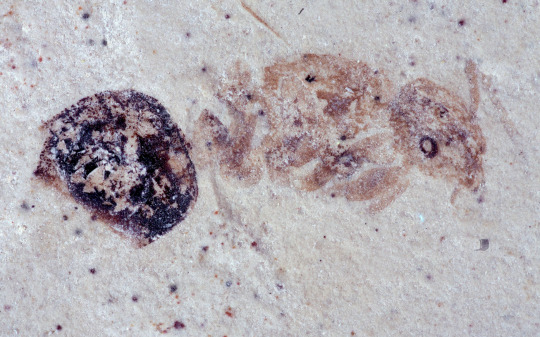
Sometimes a fossils are like photographs. These ants preserved in the Green River seem like they could come alive and walk right out of the stone.
Most fossils of ants are found in amber, due to their small size, sedimentary fossils must have exceptional fine grain detail to make ants recognizable.
The first image is from University of Colorado collection.
https://fossilinsects.colorado.edu/
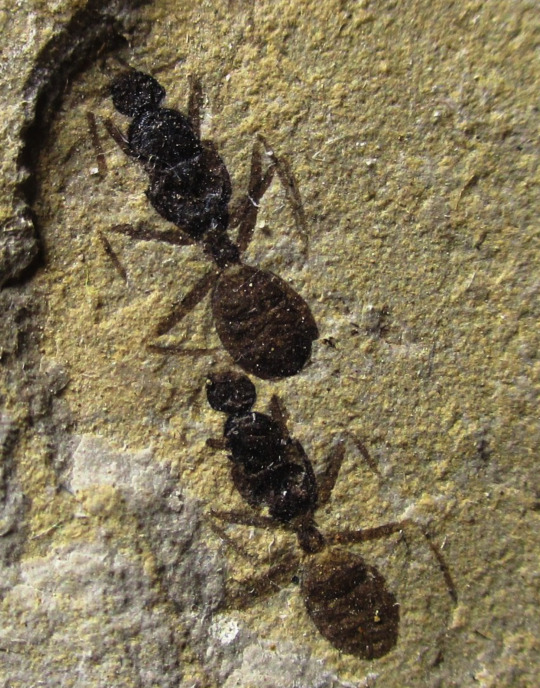
The second image I've been trying to track down-- I don't know where it is, but it is from Green River.

That first fossil is so beautiful I could cry. Look at her eye! what did she see in the Eocene? This at the dawn of the Age of the Ants... did she know her kind would inherit the whole world?
#ants#antposting#bugs#bugblr#insects#invertebrates#ant#antblr#myrmecology#antkeeping#fossil#green river#insect fossil#arthropod#arthropods#eocene
122 notes
·
View notes
Text
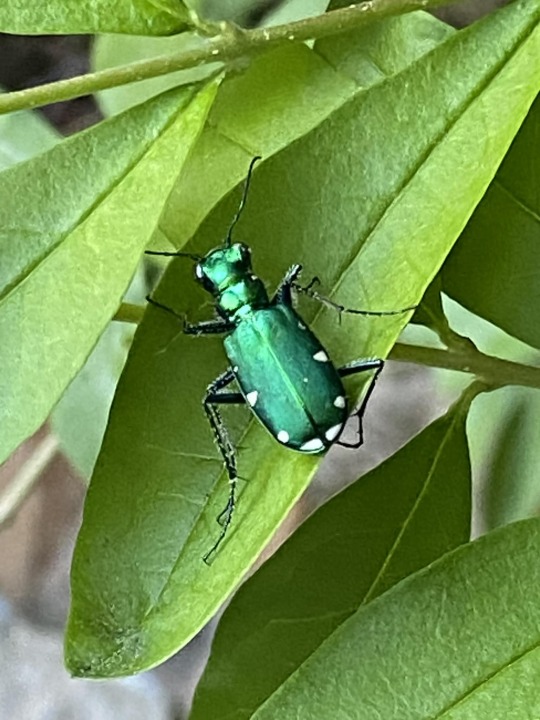
Six-spotted green beetle (Cicindela sexguttata)
#six spotted tiger beetle#cicindela sexguttata#arthropods#insect#beetle#not my photo#west virginia#greenbrier river trail#greenbrier river
4 notes
·
View notes
Text

Acacia cognata with inchworm
05-SEP-2022
Melbourne, Vic
#australia#victoria#melbourne#flowers#australian natives#native flowers#inchworm#geometer moth#insect#bug#arthropod#arthropoda#insecta#lepidoptera#geometroidea#geometridae#moth#caterpillar#bower wattle#river wattle#narrow leaved bower wattle#rosids#fabales#fabaceae#caesalpinioideae#mimosoideae#acacia#acacia cognata#yellow flowers
2 notes
·
View notes
Text
OTHERHEARTED
What does it mean to be otherhearted?
Otherhearted is a term primarily used in the therian/otherkin community that means “to identify WITH a non-human animal/creature/being.” You may have a deeply rooted connection/relation to it, and experience shifts or traits similar to the species, BUT not identify AS it. For example, I experience many bear traits and shifts, I feel a deep connection to these animals and identify WITH them, rather than identifying AS them. The “as” or “with” are very important to distinguish a theriotype/kintype from an otherhearted “identity”.
Another common term that holds the same meaning is kithtype. The etymology of the word “kith” originally means familiarity (not family), or something/someone you are connected/close to. Then the word “type” refers to what kind of identity it is (which is kith in this case).
To simplify the difference between kintypes and kithtypes; kin (to identify as/to be) and kith (to identify with/to be like).
Importance of Otherhearted
In the community people tend to showcase their theriotypes over kithtypes. They are held at a higher standard, and they are viewed as more important when it comes to our identity as a whole. But that couldn't be further from the truth. In fact, being a therian and being otherhearted can share most of the same experiences. You can indeed have shifts from kithtypes, mental and phantom. Being otherhearted can impact your life just as much, and you can wear all the same gear as a therian. Both are a part of your identity. Kithtypes can be just as prominent as kintypes.
The questioning process can be all the same as well.
Belonging in the Community
People who are otherhearted are just as valid as therians, and belong in our community all the same. We all identify as, with or simply connect to animals in different ways than people who aren't in our community. Our animal hearts, minds and souls are what connects us. Not the labels. Therians, otherkin, otherhearted, coping identities/coping links… they all belong.
As I have said before, these all share similar or same experiences. Any of us can wear gear, do quads, make posts, educate or share our identities. The sole differences are the origin of these identities, and whether you identify as or with the animal/creature/being (or if it's a voluntary identity like in the case of coping links, which I will eventually address in a separate post).
Confusing the two
It’s easy to feel lost when we’re trying to figure out what we are, and where an identity stands. Is it a theriotype? Is it a kithtype? Is it a cameo? It can be quite the confusing process. Although I think that if people knew how important being otherhearted is, they might find it easier to understand if they're kith or kin. I mean, in the end the major difference is just… are you LIKE the animal? Or ARE you the animal? Shifts don't immediately mean theriotype, so I think that's where most of the confusion lies.
Quick definition of cameo for those who don’t know of them : Cameos are simply shifts that can suddenly come and go, that arent from a known kintype. They may make a brief appearance in your life. Think of the actual word “cameo” that is used for actors who make sudden appearances in movies, and may bring an element of surprise to viewers.
I am otherhearted
I have six primary kithtypes. Each has different levels of relevance/importance to me, but are still very important to who I am as a whole. These kithtypes are; Canines (coyotes and jackals especially), Kermode Bears/Black Bears, Ravens, Snakes, Giant River Otters and Arthropods as a whole. It's a lot, but over the years, deeply rooted connections to these animals have planted themselves into my identity. I have shifts, behaviours and traits just like them!
Sometimes I even feel confused because of how prominent they can become.
Well, that’s all for now! I thought it would be important to talk about otherhearted identities for a change. Its not shared enough and I think that spreading more information could help people figure out experiences more easily.
Hope you enjoyed!
Last note - If I made spelling errors or definition errors let me know. Everything is based on research, and what I've been learning throughout the years I've been in the community. I have been active here for more than 7 years, and have been on many different platforms including Instagram, Amino, Tumblr, Discord groups and a few Forums. So I don't only explore newer information, but also older ones.
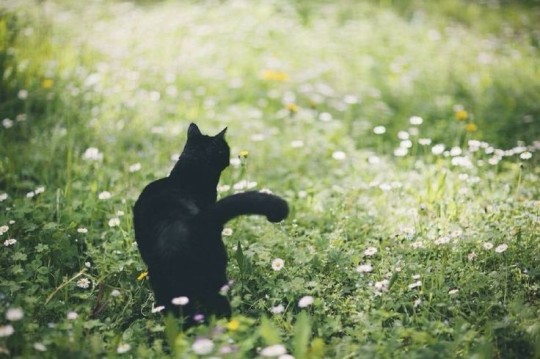
#therianthropy#alterhumanity#therian things#therian#theriotype#cat therian#therian community#therians#otherkin#otherkith#otherkinity#otherhearted#kithtypes#kith
199 notes
·
View notes
Text
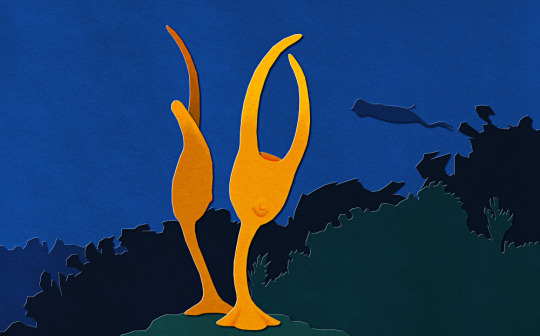
Nicknamed the "Y animal" or "wye", Escumasia roryi is an enigmatic fossil organism known from the Late Carboniferous Mazon Creek fossil beds in Illinois, USA, dating to about 308 million years ago.
Growing up to around 15cm tall (~6") this strange soft-bodied creature was Y-shaped, with two slender "arms" on each side of an apparent mouth opening, a flattened sac-like body with another opening on one side, and a long stalk ending in an attachment disc. Some specimens have uneven arm lengths, which may indicate damage from predation.
Being only known from the exceptional preservation conditions of Mazon Creek, and with nothing else quite like it in the known fossil record, Escumasia's evolutionary relationships are still a mystery. It's been tentatively linked to cnidarians – but this doesn't really fit based on its anatomy, and little further study has been done on it since its discovery in the 1970s.
It was probably a filter feeder, living attached to the seafloor and capturing suspended organic material or small planktonic prey with its arms. The environment it inhabited was a shallow tropical marine bay, located close to the equator at the time, near a large river delta that would have made the surrounding waters rather brackish. This ecosystem was dominated by cnidarians, particularly the anemone Essexella, along with various arthropods, lobopodians, polychaete worms, molluscs, echinoderms, fish, lampreys, hagfish, and other difficult-to-classify weirdos like the famous "Tully monster" Tullimonstrum.
———
NixIllustration.com | Tumblr | Patreon
References:
Clements, Thomas, Mark Purnell, and Sarah Gabbott. "The Mazon Creek Lagerstätte: a diverse late Paleozoic ecosystem entombed within siderite concretions." Journal of the Geological Society 176.1 (2019): 1-11. https://doi.org/10.1144/jgs2018-088
Nitecki, Matthew H., and Alan Solem. "A problematic organism from the Mazon Creek (Pennsylvanian) of Illinois." Journal of Paleontology (1973): 903-907. https://www.jstor.org/stable/1303070
Wikipedia contributors. “Mazon Creek fossil beds.” Wikipedia, 10 May 2024, https://en.wikipedia.org/wiki/Mazon_Creek_fossil_beds
#science illustration#paleontology#paleoart#palaeoblr#escumasia#incertae sedis#problematica#animalia#art#y animal#wye#actual ancient aliens
184 notes
·
View notes
Text
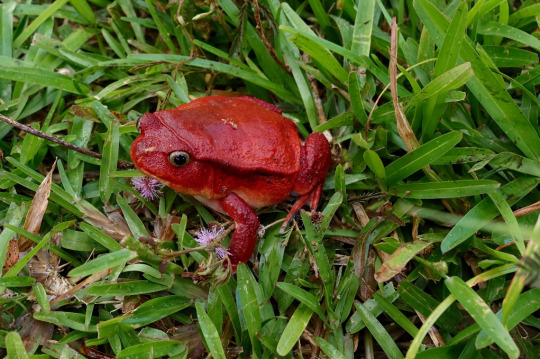
Tomato Frog (Dyscophus antongilii)
Family: Narrowmouth Frog Family (Microhylidae)
IUCN Conservation Status: Least Concern
Named for their rotund red bodies, Tomato Frogs are endemic to Madagascar where they are mostly found in wet, well-vegetated environments in the northeast. Spending the day buried beneath damp soil or leaf litter to avoid predation and dehydration, members of this species emerge at night to hunt for beetles, flies and other terrestrial arthropods, and respond to threats from nocturnal predators by inflating their bodies to appear larger and secreting a thick, sticky and mildly irritative substance from their skin, making them difficult for predators to bite or grab. Tomato Frogs breed following periods of heavy rainfall, and like almost all frogs they lay their eggs in water; males, which are smaller and paler than females, gather around suitable ponds or slow-moving rivers and streams during the night and produce low, quiet, grumbling calls, competing for the attention of females. If a female selects a male she will allow him to cling to her back and will carry him around for an extended period as she lays over 1,000 soft, transparent eggs which he fertilizes externally. Shortly after fertilization the eggs hatch into tiny, limbless, fully aquatic tadpoles that gradually develop limbs and lungs over the course of several months - after transitioning to life on land young Tomato Frogs are initially dull brown or pale yellow, gradually developing a redder colouration until they reach full maturity at 2-3 years of age.
------------------------------------------------
Image Source: Here
#tomato frog#Tomato Frog#frog#frogs#amphibian#amphibians#zoology#biology#herpetology#wildlife#African wildlife#herpetofauna
192 notes
·
View notes
Text

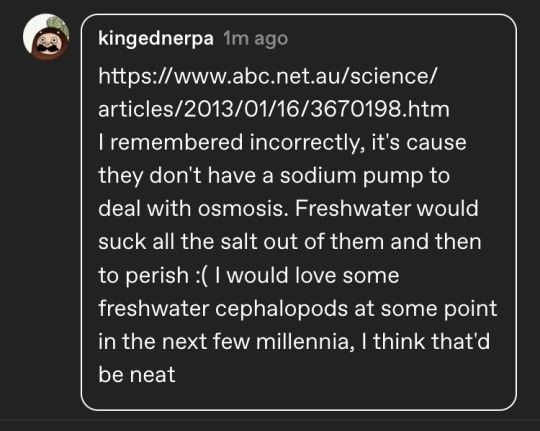
Taking these out of the comments because I think it’s interesting and I want to talk about it more
Yeah so basically, any saltwater animal (which is the default state of life on earth) that wants to live in freshwater is going to have to evolve a way to maintain the correct amount of salt and water in their body. Their body is saltier than the surrounding water so if they didn’t have a sodium pump, osmosis would cause water to flow into their body too fast for their kidneys to process and it would kill them. Freshwater is very hostile to life adapted to saltwater.
But! The correct type of sodium pump isn’t necessarily “difficult” to evolve. Mollusks (namely Gastropods and bivalves) have done so on multiple separate occasions! Not to mention that arthropods, annelids and vertebrates have all independently evolved the ability to survive in freshwater as well.
There’s nothing about the cephalopod body plan that intrinsically prevents them from evolving a sodium pump. They just… never have. And that’s not unusual, necessarily. Many groups of life on the planet haven’t evolved freshwater forms because why would they need to? The ocean is huge and full of food.
But this doesn’t mean that they never could evolve freshwater forms. They just haven’t yet. Maybe someday in the distant future shrimp will start moving up rivers and cuttlefish will follow. You never know. There could be freshwater cephalopods yet!
125 notes
·
View notes
Text

August 21, 2024 - White-browed Forest-Flycatcher (Fraseria cinerascens)
These flycatchers are found in forests near rivers, lagoons, and creeks in parts of western Africa. Foraging alone and in pairs, they eat mostly insects and other arthropods, as well as small fruits, capturing prey in short flights or plucking it from surfaces. Females build cup-shaped nests from leaf skeletons, moss, rootlets, and fungus over bases of moss, twigs, leaves, lichen, rootlets, and plant fibers in cavities, often above water. They incubate clutches of one or two eggs alone but both parents feed the chicks.
#white-browed forest-flycatcher#muscicapidae#fraseria cinerascens#bird#birds#illustration#art#water#birblr art
53 notes
·
View notes
Note
Hello! as a fictional bug expert, I was wondering if you had any thoughts on Bloodflies from Dishonored 2? (fun fact: i searched your blog to see if you’d mentioned them and the only post that came up was an ask from years ago, also from me, talking about the river krusts in dishonored 1 lmao. i swear i play other games!!)
Oh yeah I remember the krusts, and how the wiki thinks they're mollusks and they even make "pearls" but they are definitely goose barnacles!
The bloodflies are funny because officially they're supposed to be insects, from what I've read, but anatomically they're as different from insects as insects are from shrimp.


Maybe that's just because it wasn't designed by anyone who really wanted to create a realistic speculative insect, but these only have four legs, each leg only has four segments, they have perfect ball joints that aren't quite like any current Arthropod, the mouth structure isn't anything like the proboscis of any modern fly or mosquito, the body seems fused into one large streamlined segment, they have no tarsal claws and their inner organs look totally alien.
Then there's the fact that apparently these are a juvenile stage, and they become what the wiki calls a kind of wingless "beetle" when they mature. Do they call them beetles in-game? It doesn't look like that stage even has official artwork?
In our world all flying insects are already adults. Except for one weird group of mayflies who go through two different winged stages, any insect you see with usable wings is finished growing for good, so for an arthropod to go backwards from that is completely alien!
Aesthetically I like how bird-like they look, like stirges from D&D
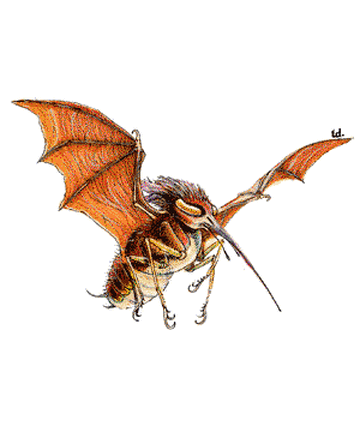
Maybe that was even a part of their inspiration?
If they did evolve or mutate from an insect though, I bet it was a lousefly
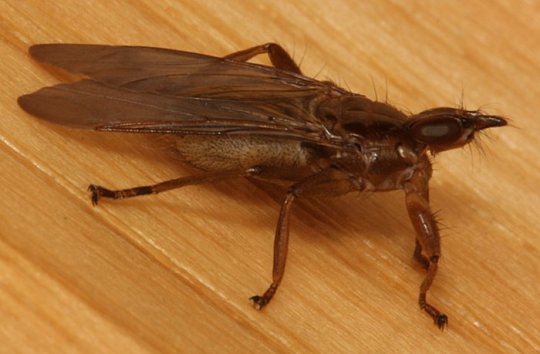
This is making me want to do more articles on my actual website that just break down a single creature or monster, without necessarily being part of a whole series like the Pokemon reviews. I did think for a while that I should do just "random" daily creature analyses or by request. I should probably go back to that.
115 notes
·
View notes
Text
Last Life with divine domains
Part 1: Rules and Domains.
Rules:
Last Life mechanics but everyone has an origin that assigns them a divine domain with powers and abilities.
Lizzie, Mumbo and Pearl will have completely randomized domains... for the other players they will have a domain that is connected in some way to the one they had in this version of Third Life.
For example In Third Life Scott's domain was Ice, possible domains for him could be: winter (as the season of ice), snow biomes, water (as ice is just a state of water) or crystals (as ice is a crystal)... I put these in a wheel and randomly choose one.
Possible Domains
In here are the possible domains they could have gotten. In [] is their 3rd Life domain.
BdoubleO - [Light] - Day, Sun, Colour, Lamps & torches.
BigB - [Weaving and Armor] - Protection, Warmth, Farm animals, Fate (as weaving is associated with it).
Cleo - [Stagnation] - Change (as opposite), Swamps (as biome of stagnation), Stone (as considered immutable).
Etho - [Darkness] - Night, Shadows, Depths, The Void, Mist, Secrets, Mobs.
Impulse - [Iron & Gold] - Ores & Caves, Copper & Amethyst, Redstone, Diamonds, Tools.
Grian - [Memory & Knowledge] - Perception, Wisdom, Books, Truth, Sight.
Jimmy - [Forests] - Jungles, Swamps, Deserts, Mountains, Snow biomes ecc (as all other biomes), Wilderness, Wood work, Nature.
Joel - [Ground] - Sand, Stone, Plains & Fields, Mountains, Caves, Nature, Compost, Agricolture, Earth.
Martyn - [Justice & Punishment] - Goverment, Law & Rules, Execution, Revenge, Power.
Ren - [Pain & Sorrow] - Regret, Desolation & Loneliness, Grief, Fear.
Scar - [Paths & Roads] - Travel, Merchants and Commerce, Connection, Rivers (as water roads).
Scott - [Ice]. - Winter, Water, Crystals.
Skizz - [Wither & Decay] - Destruction, Death, Poison, Regeneration & Rebirth.
Tango - [Coal & Flame.] - Fire & Forge, The Nether, The Hearth & Campfires, Energy.
Domains
And this is the list with the chosen domains including the new players.
BdoubleO - Day.
BigB - Farm animals.
Cleo - Change.
Etho - Mist.
Impulse - Diamonds.
Grian - Sight. (Wow, the randomizer is a watcher Grian truther)
Jimmy - Wilderness.
Joel - Mountains.
Lizzie - Storms.
Martyn - Law & Rules.
Mumbo - War. (Poor Mumbo)
Pearl - Spring. (Persephone and Pearl both start with P)
Ren - Fear.
Scar - Connections.
Scott - Winter.
Skizz - Poison.
Tango - The Hearth & Campfires.
Powers
BdoubleO - Permanent +1 level of Smite and Bane of Arthropods. I Resistance II during the day. Nearby spiders are pacified. Zombies and Skeletons don't spawn within 70 blocks from him. Ability 1 reverts a targeted zombie villager or witch into a normal villager. Ability 2 blesses another player with Resistance II during the day. Shifting deactivates the 70 block radius no mobs zone.
BigB - Looting II against passive mobs. Breeding mobs generate 2 children. Trown eggs deal punch damage. Van ride horses and pigs without befriending them and without saddles. Ability 1 summons 5 passive random mobs. Ability 2 turns passive mobs against specific targets. When shifting baby animals instantly become adults.
Cleo - Passive Regeneration I. Passive Speed I. x10 random tick speed in a 30 block radius from them. Negative potions effects last 50% less. Ability 1 rapidly drains targets hunger and armor durability. Every 10 minutes ability 2 turns a targeted block to a different random block. Shifting causes their name to change colour.
Etho - Passive Speed II. Name is invisible even when not shifted. Resistance to fire and lava damage. Semi-transparent. Ability 1 gives a target the blindness effect. Ability 2 sets everyone's render distance to 0. When shifting players closer then 10 blocks have their render view set to 0.
Impulse - Resistance I and Regen I when wearing diamonds. Haste II when using diamond tools. x2 diamonds when mining ore. Villagers trade with diamonds instead of emeralds. Ability 1 creates diamond spikes in a 3 block radius. Ability 2 turns the player into diamond (Protection IV) for 3 seconds. Shifting near a player will steal part of the diamonds they might have in their inventory.
Grian - Health is shown on top of entities. Passive Night vision. Sees exclamation marks on top of trapped chests and tnt minecarts. At the start of each session he knows how many boogeyman are active, not who, just how many. Ability 1 turns wood, grass and leaves invisible for a few seconds. Ability 2 gives Invisibility for a few seconds. Shifting gives access to a mini map.
Jimmy - Regen II when touching leaves, flowers, ferns, or tall grass. Untamed Wolves and Foxes closer then 5 blocks are tamed automatically. Tall grass and ferns have a small chance of dropping loot when harvested. When hit spawns 2 bees to defend him. Ability 1 bonemeals a large area without needing bonemeal. Ability 2 turns wolves tamed by other players into Jimmy's pets. Invisible when hiding (shifting) on trees or in tall grass.
Joel - Speed I and Strenght I while in extreme hills and mountain biomes. Passive Feather falling II. Additional Resistance at very high altitudes. Bigger reach. Ability 1 creates a rock wall to stop entities. Ability 2 creates a rock platform that raises the user. Shifting gives additional extra reach.
Lizzie - Permanent Jump Boost III and Feather Falling I. 5% chance of summoning lightning when hitting enemies. Resistance I and Regen I during rain and storms. Immunity to fire, blast and lightning damage. Ability 1 summons rain or storm weather. Ability 2 pushes entities far away. When shifting becomes a lightning rod.
Martyn - Protection II against players with more or equal number of lives. Isn't forced to leave his alliance once red. Access to a list of every life trade. Strenght I against Boogeymen. Ability 1: At the beginning session Martyn is given 5 rules to choose from, the rule chosen is applied for the whole session. Ability 2 summons an iron golem against mobs. When shifting has a chance of blocking hits.
Mumbo - Passive +1 level of Efficiency and +2 levels of Sharpness when using weapons. Passive +1 levels of protection on armor. Defending with a shield has a 20% counter attack chance. When shooting arrows a marker will point where the arrow will hit. Ability 1 gives Strenght II and Speed II but decreases Health (like a weird barbarian rage). Ability 2 is just a dash, makes up for it by having very short cool down. Shifting reduces damage taken.
Pearl - Permanent Speed I and Jump Boost I. Regen II while nearby flowers or on moss. No hunger loss while under the sun (photosyntesis). Can eat flowers and get a random positive effect for a few seconds. Ability 1 creates roots under targets causing them to fall. Ability 2 sprays pollen at enemy giving them random negative effects. Shifting bonemeals nearby blocks.
Ren - Strenght II during the night and in light levels of 0. Endermen and creepers are scared away. Speed I when running after an entity. Access to a mob noises soundboard. Ability 1 freezes entites in fear for a few seconds. Ability 2 gives Blindness and Nausea to a target. Gives Nausea to nearby entities when shifting.
Scar - Speed I on path blocks. Faster when riding Horses and boats. Protection II when near other players. +4 max health (2 hearts). Ability 1: At the beginning of every Scar chooses two players, they will share health for the whole session (if he links himself with another player they will also have 2 extra hearts). Ability 2: Every session Scar can gift a life without losing one of his own (any other life gifted will cause him to lose one though). Shifting gives Regeneration I to himself AND nearby entities.
Scott - Resistance to fire and blast damage. Passive Frost Walker and much in the same way Lava becomes obsidian. Regen II when standing on snow or ice. Snowballs thrown do as much damage as a punch. Ability 1 trows a barrage of snowballs like a machine gun. Ability 2: Once a session can change a 64x64 area into a snow plains biome... Shifting toggles off The Frost Walker effect.
Skizz - Immunity to Poison, Hunger and Wither damage. Rotten flesh gives 3 extra hunger. 20% of poisoning entities. 20% of giving Nausea to entities. Ability 1 trows a lingering poison potion. Ability 2 summons a cave spider. Shifting gives Nausea to nearby entities.
Tango - Resistance to fire and blast damage. Strenght I and Regen II when near campfires. Permanent Night vision. Can eat coal and wood to gain hunger. Ability 1 heals either himself or another entity. Ability 2 trows a burning ember at a target. Shifting causes smoke to appear but causes any attacker to a catch on fire.
Consequences for permadeath
Permadeath influences the domains assigned negatively.
BdoubleO - Day lasts half as long.
BigB - Chickens, sheeps, pigs and cows are stuck at half an heart and don't drop loot.
Cleo - Slower regeneration.
Etho - -50% render distance.
Impulse - -50% durability to diamond gear.
Grian - -50% render distance.
Jimmy - All leaves blocks disappear, Nausea in forests or taiga biomes.
Joel - Grass turns into course dirt, Slowness I when touching course dirt.
Lizzie - Weather is set to rain forever.
Martyn - Red lives lose 2 max health.
Mumbo - Weapons deal less damage and Armor protects less.
Pearl - All flowers are replaced by wither roses.
Ren - Nights last twice as long and are darker
Scar - Life trading stops working.
Scott - Snow and ice disappear, Weakness I when in cold biomes.
Skizz - All mobs have a chance of inflicting poison.
Tango - Campfires, torches and lanterns stop working
Third Life
Next Part
(hi @shortystack75 and @easily-distracted-by-fandom I started the sequel)
#trafficblr#last life#bdubs#bigb#traffic smp#zombiecleo#Etho#grian#jimmy solidarity#joel smallishbeans#lizzie ldshadowlady#impulsesv#martyn inthelittlewood#mumbo jumbo#pearlescentmoon#rendog#goodtimeswithscar#scott smajor#skizzleman#tangotek
32 notes
·
View notes
Text



I went outside today to poke around the river and found various arthropods
26 notes
·
View notes
Text
Spectember D12: Alternative history
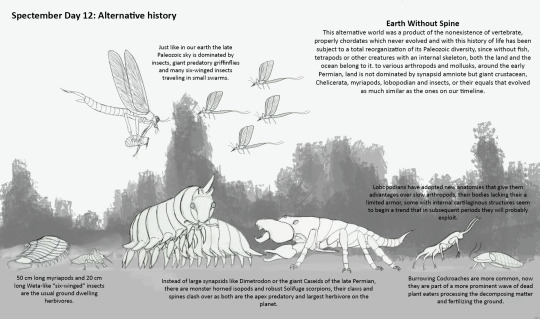
The early Permian of this alternative timeline physically looks almost the same, same geography, same flora, same events of mass extinction, but there is a considerable difference that is remarkable when one checks on the fauna, there are arthropods wandering around, of different sizes, of different shapes, alongside them there are other strange velvet worm like forms, some large mollusks, but what we could recognize nowhere to be found; in the rivers, there are more arthropods and mollusks, and even some large worms, but not bony fishes, sharks or anything that resemble a vertebrate, this world have never seen vertebrates ever.
Something happened through the beginning of the Paleozoic that caused to vertebrates to never evolve, leaving a gap in history that only other animals would fill on their ways.
Moving towards the Silurian and Devonian started to show the consequences of this change as without any type of fish, shark, placoderm, anything that we could relate to the the early paleozoic vertebrate diversification did not happen and the result of such vacuum was the diversity of arthropods and mollusks, some larger species of marine arthropods/panarthropods evolved, some larger mollusks did evolve too, cephalopods and gastropods became predominant where large marine vertebrates should dominate, and in the coasts the trend of arthropod conquest was ongoing as on our world, evolving convergently things like insects, myriapods and arachnids, alongside many other terrestrial crustacean species.
The carboniferous had a different face on land now that since there were not tetrapods taking over and with arthropods like insects and arachnids evolving similarly to our world species, they were fully conquering the planet with diverse and large sized forms, from the early carboniferous to the cooler late period, insects were dominant in numbers on land and the sky, myriapods were the usual predominant herbivores, and arachnids took over predatory roles, being scorpions the apex predators, secondarily were with them some isopod like forms, more packed and suited for dry land so they could extend off the humid forest regions, as well velvet worms which started to be more prominent in some minor parts of the ecosystem.
Up to the early Permian with the desertification of the landscape and loss of environment have pushed the most adaptable species on changing to face the new life conditions, many of the gigantic forms remained, new ecological trends started to appear within some groups, and so this spineless version of the Permian is full of a new cast of arthropods.
The north america of the Early Permian is a land dominated by 50 cm long Solifuge-like scorpions that have evolved with robust chelicerae, more used to large prey they are the apex predators on land, meanwhile in the sky 40 cm of wingspan robust griffin fly predators have evolved, more heavier lethal than any other odonatan, herbivorous palaeodictyopterans still swarm around as well; on the ground is different types of omnivorous and herbivores arthropods going along, there are Arthropleura-like myriapods, but along them some other arthropod herbivores have developed more chubby and taller, these isopod-like armored forms are as big as 1 m, they are close or even heavier than any of the flat Myriapoda; smaller herbivores surround them along, such as 20 cm long flightless cockroaches and Weta-like Palaeodictyopterans are common small herbivores; lobopodians grew up to 30 cm in length, gracile and are among the most agile terrestrial animals on land, sort of evolving a complex inner cartilage skeleton, might become the blueprint of a new future group that will take over in the next periods.
#speculative evolution#alternative evolution#arthropod#paleozoic#permian#insects#myriapods#velvet worm#lobopodia#arachnids
104 notes
·
View notes
Text

“Defeated”
“In August 2021, I found this spider near a small river in the Peruvian Tambopata rainforest. It was infested with a parasitic Ophiocordyceps fungus. This so-called “zombie fungus” infects arthropods by penetrating their exoskeleton. The fungus is able to control the behavior of its host. In this case, the spider was “compelled” to seek a location favorable for the growth of the fungus. After killing the host, the fungus fully metabolizes the inner organs of the spider and produces fruiting bodies that release spores to infect new victims.”
by Roberto Garcia Roa (Spain).
2023 European Wildlife Photographer of the Year
#roberto garcia roa#photographer#spain#european wildlife photographer of the year#defeated#spider#peru#ophiocordyceps fungus#fungi#zombie fungus#nature
17 notes
·
View notes
Text
We've noticed a gap in language for specifically referring to animals in systems that function like/mostly like normal animals. so I'm coining this term. I have been using it for awhile now in therapy and when talking to other we know systems.
Beastie (plural Beasties)
Refers to animal alters/headmates in systems/collectives that cognitively function in a way different than that of the non-animal altars/headmates in the system/collective.
Beasties do NOT need to be known animal. They can be anything that would be clearly identified as an animal (e.g mythical beasts, fictional hybrids, speculative animals, elemental animals, and the like)
Not all animals in systems/collectives are beasties due to the fact that the term refers to a animalistic way of functioning. Whether or not the term applies to a certain alter/headmate is intentionally somewhat vague, and and is dependent upon the context of the other alters/headmates in the system/collective.
Differs from the term non-human alter/headmate in that not all non-human alters/heamates are animals, and a lot of non-human alters/headmates function cognitively similarly to their human counterparts.
I am part of a OSDD-1"B" system, and consider myself "Endo complex", I don't care what type of system/plurals use this term. As I'm coining it to fill a gap in language.
HOWEVER I would like this term to be exclusive to systems/plurals, and exclusively to refer to alters/headmates that are literally animals. It is not to be used in contexts of pet regression, animal-hearted, otherkin/singlet therianthropes, petplay, etc. That is just not what the term is meant to be used for.
And here's a flag just for fun


with and without symbol. symbol used here. If anyone is willing to design a unique symbol specifically for this flag I would greatly appreciate it.
Navy Blue is for aquatic beasties such as fish, sharks, aquatic mammal, aquatic invertebrate, etc.
Deep Sea Green is for amphibious and semiaquatic beasties such as frogs, salamanders, newts, caecilian, river otters, crocodilians, penguins, etc.
Forest Green is for terrestrial and arboreal beasties such as most mammals, birds, reptiles, and many arthropods.
Olive Green is for herbivorous beasties such as horses, toucans, sloths, deer, tortoises, hummingbirds, aphids, bees, and many more.
Beige is for omnivorous beasties such crows, hogs, bears, canines, some lizards, chickens, many Testudines, and many more.
Brass is for carnivorous and insectivorous beasties such as felids, birds of prey, snakes, crocodilians, spiders, sharks, most bats, some lizards, and many more.
Brick Red is for beasties that are animals that can exist in the outerworld, like the animals mentioned above. This stripe is also for beasties that are Introjects or factives of real animals.
Purple Red is for hybrid beasties which could be something possible in the outerworld like ligers, or something impossible like griffins. This stripe is also for beasties that are Introjects or faitives/fucktives of animals.
Deep Violet is for beasties that are mythical creatures such as dragons, unicorns, phoenixes, cryptids, and more. This stripe is also for beasties that are Introjects or fictives of fictional animals.
#-v#Beastie#Beasties#system terms#coining#plural term#system coining#plural coining#flags#my flags#non human alter#animal alter#endo neutral#plural system#osdd system#traumagenic system#did alter#did system#dissociative system#osdd alter#our flags
33 notes
·
View notes
Photo
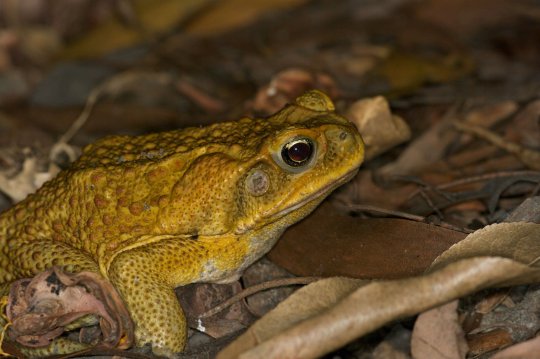
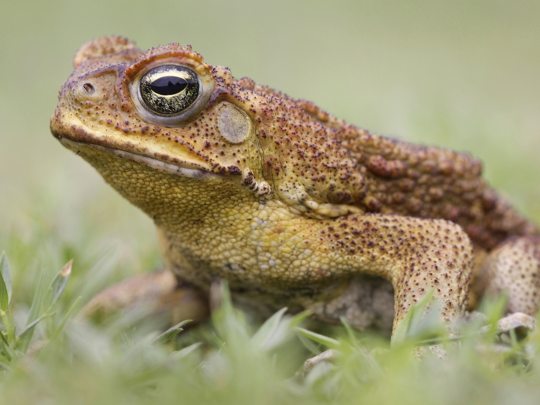

Caring for the Cane Toad
Also known as the giant neotropical toad or marine toad, the cane toad (Rhinella marina) is a large species of toad native to Central and South America. They are most often found near permanent sources of water like lakes, wetlands, and slow-moving rivers, as well as tropical rainforests and open grasslands. R. marina can also be found in human-modified areas, like gardens and farmland. They have a wide range of temperatures which they can tolerate; some populations in North America can tolerate up to 53% of their bodily fluids freezing.
Despite their preference for living near water, cane toads are primarily terrestrial. They feed on a wide range of arthropods, birds, small reptiles, and small mammals-- anything they can fit in their mouths. Prey is mainly identified via movement and smell, as R. marina has poor vision and hunts at primarily night. During the day the marine toad hides under logs or in foliage to avoid predators. The most common threats in its native region include caimans, birds of prey, snakes, eels, large fish, and bullet ants. To deter these predators, the cane toad can emit a milky-white substance known as bufotoxin, which is poisonous to many species. Individuals will also inflate their lungs, puffing up their bodies to appear larger than they really are.
R. marina is easily identified as the largest species in the family Bufonidae, reaching up to 24 cm (9.5 in) long and weighing an average of 106g(3.75 oz). Females are significantly larger than males. On adults, the head and back are covered with large wart-like bumps, and the color ranges from light grey to red to dark brown. Juveniles have smooth skin and are usually darker in color. Because of their terrestrial nature, marine toads lack webbing between their fingers.
The giant neotropical toad is capable of breeding year-round, so long as resources are plentiful. Males congregate in bodies of slow-moving or still freshwater, and call loudly to attract a mate. Depending on the number of males and the size of their breeding ground, males may also fight for dominance. After a female choses a mate (or several), she may lay up to 25,000 eggs in strings up to 20m (65 ft) long. The eggs take only 2-7 days to hatch, but few make it past the tadpole stage, which lasts about a month. Only about 0.5% of cane toads reach adulthood, which takes about a year. Without predators R. marina can live up to 10 years.
Conservation status: The IUCN lists the cane toad as Least Concern, due to their large native population and adaptability. Unfortunately, the cane toad has been introduced in many areas, including Australia, southeast Asia, the Caribbean, and North America, and is considered a highly invasive species.
If you like what I do, consider leaving a tip or buying me a kofi!
Photos
Chris Ison
John Sullivan
Richard Shine
#cane toad#Anura#Bufonidae#south american toads#true toads#toads#amphibians#wetlands#wetland amphibians#freshwater fauna#freshwater amphibians#lakes#lake amphibians#rivers#river amphibians#tropical forests#tropical forest amphibians#urban fauna#urban amphibians#central america#south america#biology#zoology#animal facts
221 notes
·
View notes